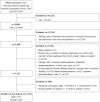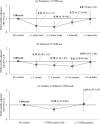Association between use of vitamin and mineral supplement and non-alcoholic fatty liver disease in hypertensive adults
- PMID: 37608217
- PMCID: PMC10444877
- DOI: 10.1038/s41598-023-40868-1
Association between use of vitamin and mineral supplement and non-alcoholic fatty liver disease in hypertensive adults
Abstract
Non-alcoholic fatty liver disease (NAFLD) is the most common hepatic metabolic disorder in hypertensive adults. Impaired metabolism of micronutrients may increase NAFLD risk by exacerbating oxidative stress, insulin resistance, and inflammation among hypertensive adults. In this first cross-sectional analysis of 7,376 hypertensive adults with 2,015 NAFLD cases in the Korea National Health and Nutrition Examination Survey, vitamin and mineral supplements (VMS) use was identified via questionnaire. NAFLD was defined by a hepatic steatosis index > 36. Multivariable-adjusted odds ratios (MVOR) and 95% confidence intervals (CIs) were calculated using logistic regression models. In our study, 18.6% were current users of VMS; of these, 76.7% used multi-vitamin/mineral supplements. Current VMS users had significantly lower odds of NAFLD, compared with non-users (MVOR [95% CI]: 0.73 [0.58-0.92]). The inverse association became attenuated and non-significant among those consuming VMS at higher frequency (≥ 2 times/day), for longer duration (> 16 months), and taking ≥ 2 VMS products. The inverse association with current use of VMS was only evident in those aged < 56 years (MVOR [95% CI]: 0.54 [0.40-0.72]) and men (MVOR [95% CI]: 0.56 [0.40-0.80])(Pinteraction ≤ 0.04). Our results suggest that VMS use may lower NAFLD risk, particularly among younger or male hypertensive adults, if taken in moderation.
© 2023. Springer Nature Limited.
Conflict of interest statement
The authors declare no competing interests.
Figures
Similar articles
-
Association between Dietary Vitamin C Intake and Non-Alcoholic Fatty Liver Disease: A Cross-Sectional Study among Middle-Aged and Older Adults.PLoS One. 2016 Jan 29;11(1):e0147985. doi: 10.1371/journal.pone.0147985. eCollection 2016. PLoS One. 2016. PMID: 26824361 Free PMC article.
-
Moderate to severe vasomotor symptoms are risk factors for non-alcoholic fatty liver disease in postmenopausal women.Maturitas. 2018 Nov;117:22-28. doi: 10.1016/j.maturitas.2018.08.011. Epub 2018 Aug 31. Maturitas. 2018. PMID: 30314557
-
Low skeletal muscle mass is associated with non-alcoholic fatty liver disease in Korean adults: the Fifth Korea National Health and Nutrition Examination Survey.Hepatobiliary Pancreat Dis Int. 2016 Feb;15(1):39-47. doi: 10.1016/s1499-3872(15)60030-3. Hepatobiliary Pancreat Dis Int. 2016. PMID: 26818542
-
Association of serum vitamin C with liver fibrosis in adults with nonalcoholic fatty liver disease.Scand J Gastroenterol. 2022 Jul;57(7):872-877. doi: 10.1080/00365521.2022.2041085. Epub 2022 Feb 21. Scand J Gastroenterol. 2022. PMID: 35189786
-
[Specialized vitamin-mineral supplements for persons in extreme conditions].Vopr Pitan. 2022;91(6):6-16. doi: 10.33029/0042-8833-2022-91-6-6-16. Epub 2022 Oct 10. Vopr Pitan. 2022. PMID: 36648178 Review. Russian.
Cited by
-
The Interplay between Liver and Adipose Tissue in the Onset of Liver Diseases: Exploring the Role of Vitamin Deficiency.Cells. 2024 Sep 30;13(19):1631. doi: 10.3390/cells13191631. Cells. 2024. PMID: 39404394 Free PMC article. Review.
-
Diet, exercise, and supplements: what is their role in the management of the metabolic dysfunction-associated steatotic liver disease in children?Endocrine. 2024 Sep;85(3):988-1006. doi: 10.1007/s12020-024-03783-7. Epub 2024 Mar 22. Endocrine. 2024. PMID: 38519764 Free PMC article. Review.
References
-
- Zhou B, Carrillo-Larco RM, Danaei G, Riley LM, Paciorek CJ, Stevens GA, Breckenkamp J. Worldwide trends in hypertension prevalence and progress in treatment and control from 1990 to 2019: A pooled analysis of 1201 population-representative studies with 104 million participants. Lancet. 2021;398(10304):957–980. doi: 10.1016/s0140-6736(21)01330-1. - DOI - PMC - PubMed
Publication types
MeSH terms
Substances
LinkOut - more resources
Full Text Sources
Medical



